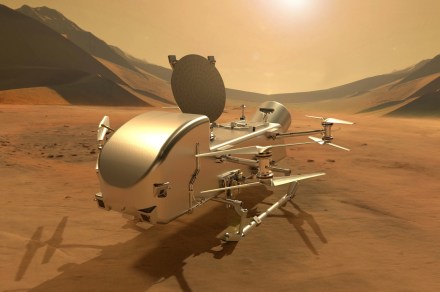NASA is taking what it’s learned from its groundbreaking Ingenuity Mars helicopter to create an even more complex flying machine to explore Titan, Saturn’s largest moon. Whereas Ingenuity features a single rotor and a height of just 19. 3 inches, Dragonfly has eight rotors and is the size of a small car.
Recommended Videos A team of researchers led by the Johns Hopkins University Applied Physics Laboratory (APL) in Maryland has the advantage of Titan’s thick atmosphere, which will be easier to fly in than Mars’ considerably thinner atmosphere. Its low gravity will also help the flying machine to stay airborne. Related How NASA’s Dragonfly mission will assess Titan for habitability NASA video shows close-up look at moon rocket during recent test NASA confirms date for final test of its mega moon rocket In a recent update on the progress of Dragonfly’s development, NASA’s Patricia Talbert said the mission team has been paying regular visits to the space agency’s Langley Research Center in Hampton, Virginia, to test out Dragonfly’s flight systems inside the facility’s various wind tunnels, with gathered data helping it to refine the aircraft’s design.
On its latest trip to NASA Langley, the team tested a half-scale Dragonfly while focusing on two particular flight configurations: Dragonfly’s descent and transition to powered flight upon reaching Titan, and forward flight over the moon’s surface. “We tested conditions across the expected flight envelope at a variety of wind speeds, rotor speeds, and flight angles to assess the aerodynamic performance of the vehicle,” test lead Bernadine Juliano of APL said in a release. “We completed more than 700 total runs, encompassing over 4,000 individual data points.
All test objectives were successfully accomplished and the data will help increase confidence in our simulation models on Earth before extrapolating to Titan conditions. ” Artist’s impression of the Dragonfly rotorcraft lander on the surface of Titan, Saturn’s largest moon. NASA/Johns Hopkins APL/Steve Gribben Dragonfly is NASA’s only mission to the surface of another ocean world.
It’s expected to reach Titan in 2034 after launching from Earth in 2027. Titan bears some similarities to the very early Earth and scientists hope that with its suite of cameras, sensors, and samplers, Dragonfly will be able to make discoveries that tell us how life may have begun on our own planet. “With Dragonfly, we’re turning science fiction into exploration fact,” said Ken Hibbard, Dragonfly mission systems engineer at APL.
“The mission is coming together piece by piece, and we’re excited for every next step toward sending this revolutionary rotorcraft across the skies and surface of Titan. ” Editors’ Recommendations NASA performs critical tests for Artemis V moon rocket NASA shares its skywatching tips for September NASA completes prelaunch test of its mega moon rocket NASA ready for key launchpad test of its mega moon rocket NASA’s new moon rocket to depart launchpad after failed test.
From: digitaltrends
URL: https://www.digitaltrends.com/space/nasa-tests-dragonfly-drone-destined-for-titan/



